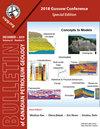Revised biostratigraphic and thermal alteration interpretations for the Paleozoic of the Hopedale Basin, offshore Labrador, Canada
Q3 Earth and Planetary Sciences
引用次数: 1
Abstract
Paleozoic rocks occur in seven wells in the Hopedale Basin, offshore Labrador (Hopedale E-33, South Hopedale L-39, Tyrk P-100, Gudrid H-55, Roberval K-92, Indian Harbour M-52, and Freydis B-87), where they represent erosional remnants primarily associated with Cretaceous syn-rift half grabens. Previous palynological studies have reported a range of ages for the Paleozoic in these wells, including Ordovician, Devonian, Carboniferous, and undifferentiated Paleozoic. Palynological analyses in the present study confirm that recovery is limited, primarily due to the predominance of lithologies that hinder palynomorph preservation, specifically dolostones. Palynomorphs (predominantly acritarchs and chitinozoans) have been analyzed from new and archived samples from the seven wells and have, for the first time, produced consistent age determinations for the Paleozoic strata in all wells: palynomorph assemblages considered in place indicate a Middle to Late Ordovician age. Thermal maturity was determined from Ordovician acritarchs and leiospheres observed in the Gudrid H-55, Roberval K-92, Indian Harbour M-52, and Freydis B-87 wells, with thermal alteration indices (TAI) ranging from approximately 5+ to 6+ (dry gas). Carboniferous miospores are present from Paleozoic strata in the southern Hopedale Basin wells, where their TAI values range from 3+ to 4. These miospores are interpreted as contaminants introduced into the samples via cavings or as drilling mud contamination. The data presented here provides new biostratigraphic constraints for the Paleozoic of the Hopedale Basin (Middle to Late Ordovician), facilitates the correlation of the Paleozoic intervals in these wells, and enables the consideration of Labrador margin Lower Paleozoic strata in regional studies as well as in paleogeographic and paleoenvironmental reconstructions.加拿大拉布拉多近海Hopedale盆地古生代生物地层和热蚀变订正解释
在拉布拉多海上Hopedale盆地的7口井(Hopedale E-33、South Hopedale L-39、Tyrk P-100、gurid H-55、Roberval K-92、Indian Harbour M-52和Freydis B-87)中发现了古生代岩石,这些岩石代表了主要与白垩纪同裂谷半地堑有关的侵蚀残余。以前的孢粉学研究报告了这些井中古生代的年龄范围,包括奥陶纪、泥盆纪、石炭纪和未分化的古生代。本研究中的孢粉学分析证实,恢复是有限的,主要是由于岩性的优势阻碍了孢粉形态的保存,特别是白云岩。从7口井的新样品和存档样品中分析了孢芽状体(主要是树状体和几丁质动物),并首次对所有井的古生代地层进行了一致的年龄测定:所考虑的孢芽状体组合表明了中奥陶世至晚奥陶世。利用Gudrid H-55井、Roberval K-92井、Indian Harbour M-52井和Freydis B-87井观测到的奥陶系烃源岩和层球热成熟度测定,热蚀变指数(TAI)约为5+ ~ 6+(干气)。在Hopedale盆地南部古生代地层中发现石炭系微孢子,其TAI值在3+ ~ 4之间。这些微孢子被解释为通过崩落或钻井泥浆污染引入样品的污染物。研究结果为Hopedale盆地(中晚奥陶世)古生代提供了新的生物地层约束条件,促进了这些井中古生代层段的对比,为Labrador边缘下古生代地层的区域研究以及古地理和古环境重建提供了参考依据。
本文章由计算机程序翻译,如有差异,请以英文原文为准。
求助全文
约1分钟内获得全文
求助全文
来源期刊

Bullentin of Canadian Petroleum Geology
Earth and Planetary Sciences-Geochemistry and Petrology
CiteScore
2.50
自引率
0.00%
发文量
0
期刊介绍:
The Bulletin of Canadian Petroleum Geology is a peer-reviewed scientific journal published four times a year. Founded in 1953, the BCPG aims to be the journal of record for papers dealing with all aspects of petroleum geology, broadly conceived, with a particularly (though not exclusively) Canadian focus. International submissions are encouraged, especially where a connection can be made to Canadian examples.
 求助内容:
求助内容: 应助结果提醒方式:
应助结果提醒方式:


